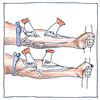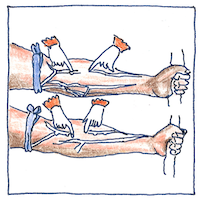William Harvey
anatomy

|
Circulation of the blood
William Harvey dissected fish, snakes, snails, shrimp, and pigeons but the living action of the heart was difficult to study. Galen taught that the body’s organs consumed venous blood from the liver and arterial blood from the heart. For him, the blood didn’t circulate. William Harvey measured the amount of blood passing through the heart to show that Galen was wrong. William Harvey blocked a vein and observed the heart fill up; he blocked an artery and observed the heart empty itself. He tried to push blood down a vein but it wouldn’t go; but he could easily push the blood up. Then he found the opposite with an artery. Thus William Harvey analyzed the heart, the veins, the arteries, and the dynamics of the flow of the circulation of the blood.
Too small to see
Harvey could not see capillaries with his simple magnifying lens so he could not show how the blood moved from the arterioles to the venules.
De Motu Cordis
The motion of the heart willing or unwilling hops like a bird to a limb falls like light to float on a lake gently impels the soul like pushing a child in a carriage but what is the soul? what is life? what is love? They are not forces or weights but levers and fulcrums. They are not our similes or rhymes but our reasons for them.



William Harvey was the first scientist to definitely contradict the theory of spontaneous generation. His doctrine was omne vivum ex ovo (all life comes from eggs). After De Motu Cordis, in 1651 he published Exercitationes de generatione animalium on the generation of animals, that is, embryogenesis.
See also in The book of science:
Readings in wikipedia: